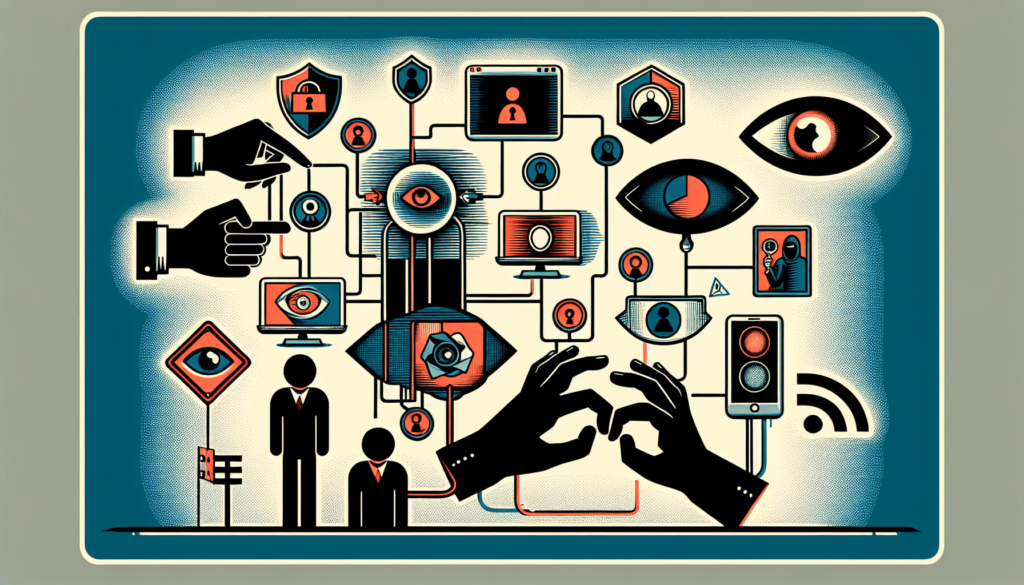In today’s digital landscape, the increasing prevalence of social media has brought about new challenges in the form of social engineering. As individuals share more personal information online, they become vulnerable to manipulation by malicious actors seeking to exploit this data for their own gain. This article aims to shed light on the risks associated with social engineering in the age of social media, providing insights and practical advice to help you safeguard your personal and professional information from falling into the wrong hands.
Social Engineering
Definition of social engineering
Social engineering refers to the manipulation of individuals to gather sensitive information, gain unauthorized access to systems, or influence their behavior for nefarious purposes. It is a psychological technique used by fraudsters and hackers to exploit human emotions, trust, and naivety. Instead of targeting the technical vulnerabilities of a system, social engineering exploits the vulnerabilities of individuals.
Methods of social engineering
Social engineering techniques vary, but they often involve manipulation through impersonation, deception, and exploiting human psychology. These methods include phishing attacks, baiting, clickjacking, impersonation, malware distribution, and the creation of fake profiles. By leveraging these tactics, attackers try to convince individuals to share personal information, download malicious files, or click on harmful links.
Importance of understanding social engineering
Understanding social engineering techniques is crucial in today’s interconnected world. As technology evolves, individuals and organizations become more reliant on digital platforms, making them more susceptible to social engineering attacks. By being aware of the risks and how to identify and protect against them, individuals can reduce their chances of falling victim to social engineering attempts.
The Age of Social Media
Rise of social media platforms
Social media has revolutionized the way we connect and interact with one another. Platforms such as Facebook, Twitter, and Instagram have witnessed exponential growth, enabling communication on a global scale. These platforms have become integral to both personal and professional lives, providing opportunities for networking, content sharing, and even marketing.
Role of social media in shaping society
Social media has emerged as a powerful tool for shaping public opinion, mobilizing movements, and disseminating information. It has influenced political landscapes, facilitated social activism, and transformed traditional media landscapes. This level of influence makes social media a potential target for those seeking to exploit its users for personal gain.
Vulnerabilities introduced by social media
While social media brings various benefits, it also introduces vulnerabilities that can be exploited by malicious actors. The vast amount of personal information shared on social media platforms makes it easier for attackers to gather information for social engineering attacks. Additionally, the lack of awareness among users about the risks associated with social media usage further amplifies vulnerability.

What is Social Engineering in the Context of Social Media?
Definition of social engineering in social media
Social engineering in the context of social media involves manipulation techniques used specifically on these platforms to deceive individuals, gain unauthorized access to accounts, or extract personal information. It leverages the trust and openness of users to exploit their vulnerabilities and compromise their accounts or systems.
Examples of social engineering in social media
Examples of social engineering in social media include scams that promise giveaways, fake customer service accounts seeking personal information, and clickbait links leading to malware-infected websites. Hackers may also create fake profiles to gather personal information or impersonate someone to gain the trust of others.
Goals of social engineering in social media
The goals of social engineering in social media can vary. Attackers may aim to steal personal information, such as passwords and credit card details, for financial gain. They may also seek to spread malware, gain control of accounts for malicious activities, or use social engineering as a stepping stone for further attacks.
Common Social Engineering Techniques in Social Media
Phishing attacks
Phishing is a common social engineering technique where attackers impersonate a trustworthy entity, such as a well-known brand or a social media platform, in order to deceive users into revealing sensitive information. They may use emails, direct messages, or comments to trick individuals into providing their login credentials, banking information, or other personal details.
Impersonation
Impersonation involves creating fake profiles or accounts to deceive individuals into thinking they are interacting with someone they know or trust. Attackers may impersonate friends, family members, or even celebrities to extract personal information, spread false information, or manipulate individuals’ emotions for their benefit.
Baiting
Baiting involves tempting individuals with offers or rewards in exchange for their personal information or engagement with malicious content. On social media, baiting can come in the form of enticing links, quizzes, or surveys that promise freebies or exclusive content. Once individuals take the bait, their personal information or accounts may be compromised.
Clickjacking
Clickjacking is a technique where attackers trick users into clicking on hidden or disguised buttons or links that lead to unintended actions. On social media, clickjacking typically involves disguising malicious links as captivating content, such as videos or articles, to encourage users to click on them unwittingly.
Malware distribution
Attackers may use social media platforms to distribute malware by disguising it as legitimate files or links. Malicious software can take various forms, including viruses, ransomware, or spyware. Once downloaded or clicked, the malware can enable attackers to gain access to personal information, control devices, or wreak havoc on systems.
Fake profiles and accounts
Creating fake profiles or accounts is a common social engineering tactic on social media. These fake entities might pose as potential friends, romantic partners, or even brands. By gaining individuals’ trust, attackers can manipulate them into sharing personal information, clicking on harmful links, or falling for scams.

Identifying Potential Social Engineering Attacks
Developing a critical mindset
To identify potential social engineering attacks, it is essential to develop a critical mindset while using social media. Question the authenticity of messages, consider the potential risks before clicking on links or sharing personal information, and be aware of common social engineering tactics.
Being cautious of unsolicited messages or friend requests
One way to identify potential social engineering attacks is to be cautious of unsolicited messages or friend requests. Verify the identity of the sender, especially if the person is unknown or seems too good to be true. Legitimate organizations usually follow established communication channels, and reputable individuals typically have a history of online presence.
Verifying the authenticity of accounts
Verify the authenticity of accounts before engaging with them. Look for account verification badges, check for consistent posting activity, and examine the quality of content shared. In case of doubt, use external sources or contact the organization directly to confirm the legitimacy of the account.
Checking for suspicious activity or requests
Regularly review your social media accounts for suspicious activity or requests. Be cautious of messages or posts that seem out of character, have poor grammar or spelling, or request personal information. Avoid clicking on any links or downloading files from unknown sources.
Protecting Yourself from Social Engineering Attacks
Educating oneself about social engineering tactics
One of the most crucial steps in protecting oneself from social engineering attacks is to educate oneself about common tactics and techniques used by attackers on social media. Stay informed about the latest trends in social engineering and be aware of red flags that may indicate a potential attack.
Using strong and unique passwords
Using strong and unique passwords for all social media accounts is essential. Avoid using easily guessable information, such as personal names or birthdates. Implement a password management tool to generate and store complex passwords securely.
Enabling two-factor authentication
Enabling two-factor authentication (2FA) adds an extra layer of security to social media accounts. With 2FA, a verification code is sent to a registered device whenever an account login is attempted. This adds another barrier for attackers trying to gain unauthorized access, even if they obtain the login credentials.
Regularly updating privacy settings
Regularly review and update privacy settings on social media platforms. Limit the amount of personal information visible to the public and carefully select who can view your posts and personal details. Be cautious when accepting new privacy policy terms and understand the implications of sharing information with third-party applications.
Installing reputable security software
Installing reputable security software, such as antivirus applications and firewalls, can help detect and prevent social engineering attacks. Keep the software up to date to ensure maximum protection against emerging threats.
Social Engineering Prevention by Social Media Platforms
Implementing user validation processes
Social media platforms can implement user validation processes to verify the authenticity of accounts. This can include requiring individuals to verify their identity through email or phone verification, as well as conducting periodic audits of suspicious accounts.
Providing user education about social engineering risks
Social media platforms can play a crucial role in preventing social engineering attacks by providing education about the risks and techniques used by attackers. They can offer resources, tutorials, and tips on how to identify and protect against social engineering attempts.
Monitoring and reporting suspicious activity
Social media platforms should implement robust monitoring systems to detect and investigate suspicious activity. Users should be encouraged to report any suspicious accounts, messages, or content they come across to help keep the platform safe for everyone.
Improving privacy and security features
Continued development and improvement of privacy and security features on social media platforms are essential for protecting users. Platforms should offer granular control over privacy settings, prompt users to review and update their settings regularly, and ensure data encryption and secure communication end-to-end.
The Role of Awareness and Education
Promoting awareness about social engineering risks
Awareness about social engineering risks should be promoted among social media users. Governments, organizations, and individuals should collaborate to spread awareness through campaigns, workshops, and educational resources. By educating users, the overall resilience against social engineering can be improved.
Teaching individuals about safe social media practices
Individuals should be taught safe social media practices, including how to identify and avoid social engineering attempts. This includes teaching users to verify the authenticity of accounts, recognize red flags, exercise caution when sharing personal information, and report suspicious activity or accounts.
Encouraging reporting of suspicious activity
Encouraging users to report any suspicious activity they encounter on social media is crucial. Reporting enables quick identification and remediation of social engineering attempts, preventing further damage and raising awareness about emerging tactics.
Implications for Businesses and Organizations
Risks posed to businesses and organizations
Social engineering attacks can have severe implications for businesses and organizations. They can result in financial loss, reputation damage, data breaches, and compromised systems. It is crucial for organizations to be proactive in addressing and mitigating the risks posed by social engineering attacks.
Educating employees about social engineering
Organizations must educate their employees about social engineering tactics and techniques. Training programs can help employees identify potential attacks, understand the importance of safeguarding information, and establish protocols for reporting suspicious activity.
Implementing security measures
Organizations should implement robust security measures, such as firewalls, intrusion detection systems, and multi-factor authentication, to protect against social engineering attacks. Regular security assessments, audits, and penetration testing can help identify vulnerabilities and address them promptly.
Creating incident response plans
Having a well-defined incident response plan is vital for organizations to address social engineering attacks effectively. A comprehensive plan should outline the steps to be taken in the event of an attack, including containment, investigation, communication, and recovery.
Future of Social Engineering in the Age of Social Media
Evolving tactics and strategies
As technology advances, social engineering tactics and strategies will also continue to evolve. Attackers will adapt to new platforms, exploit emerging trends, and find creative ways to manipulate individuals. Staying informed and continually updating security measures will be crucial in countering these evolving threats.
Utilization of artificial intelligence
Artificial intelligence (AI) is expected to play a significant role in the future of social engineering. Attackers may leverage AI to enhance the accuracy and effectiveness of their attacks. Similarly, AI-powered security solutions can help detect and prevent social engineering attempts by analyzing patterns, identifying anomalies, and predicting potential threats.
Continued importance of awareness and education
Awareness and education will remain vital in combating social engineering attacks in the age of social media. Regularly educating individuals about emerging threats, promoting safe social media practices, and encouraging a critical mindset can help individuals and organizations stay ahead of social engineering attacks.
In conclusion, social engineering in the age of social media presents significant risks that individuals and organizations must be aware of and prepared to mitigate. By understanding the methods and goals of social engineering, identifying potential attacks, and following best practices for protection, individuals can reduce their vulnerability to these manipulative tactics. Moreover, social media platforms must play an active role in preventing social engineering attacks by implementing user validation processes, providing user education, and enhancing privacy and security features. Through awareness, education, and collaboration, we can navigate the complexities of social engineering and maintain a safe and secure digital environment in the age of social media.



